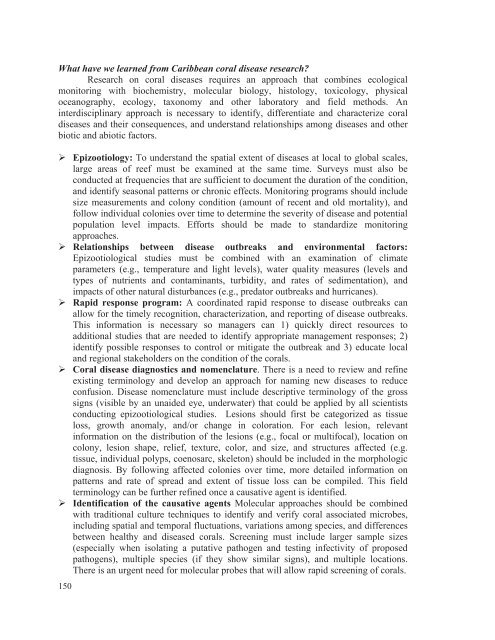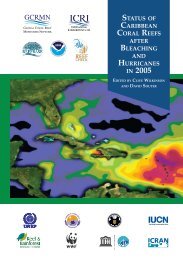Coral Health and Disease in the Pacific: Vision for Action
Coral Health and Disease in the Pacific: Vision for Action
Coral Health and Disease in the Pacific: Vision for Action
Create successful ePaper yourself
Turn your PDF publications into a flip-book with our unique Google optimized e-Paper software.
What have we learned from Caribbean coral disease research?Research on coral diseases requires an approach that comb<strong>in</strong>es ecologicalmonitor<strong>in</strong>g with biochemistry, molecular biology, histology, toxicology, physicaloceanography, ecology, taxonomy <strong>and</strong> o<strong>the</strong>r laboratory <strong>and</strong> field methods. An<strong>in</strong>terdiscipl<strong>in</strong>ary approach is necessary to identify, differentiate <strong>and</strong> characterize coraldiseases <strong>and</strong> <strong>the</strong>ir consequences, <strong>and</strong> underst<strong>and</strong> relationships among diseases <strong>and</strong> o<strong>the</strong>rbiotic <strong>and</strong> abiotic factors. Epizootiology: To underst<strong>and</strong> <strong>the</strong> spatial extent of diseases at local to global scales,large areas of reef must be exam<strong>in</strong>ed at <strong>the</strong> same time. Surveys must also beconducted at frequencies that are sufficient to document <strong>the</strong> duration of <strong>the</strong> condition,<strong>and</strong> identify seasonal patterns or chronic effects. Monitor<strong>in</strong>g programs should <strong>in</strong>cludesize measurements <strong>and</strong> colony condition (amount of recent <strong>and</strong> old mortality), <strong>and</strong>follow <strong>in</strong>dividual colonies over time to determ<strong>in</strong>e <strong>the</strong> severity of disease <strong>and</strong> potentialpopulation level impacts. Ef<strong>for</strong>ts should be made to st<strong>and</strong>ardize monitor<strong>in</strong>gapproaches. Relationships between disease outbreaks <strong>and</strong> environmental factors:Epizootiological studies must be comb<strong>in</strong>ed with an exam<strong>in</strong>ation of climateparameters (e.g., temperature <strong>and</strong> light levels), water quality measures (levels <strong>and</strong>types of nutrients <strong>and</strong> contam<strong>in</strong>ants, turbidity, <strong>and</strong> rates of sedimentation), <strong>and</strong>impacts of o<strong>the</strong>r natural disturbances (e.g., predator outbreaks <strong>and</strong> hurricanes). Rapid response program: A coord<strong>in</strong>ated rapid response to disease outbreaks canallow <strong>for</strong> <strong>the</strong> timely recognition, characterization, <strong>and</strong> report<strong>in</strong>g of disease outbreaks.This <strong>in</strong><strong>for</strong>mation is necessary so managers can 1) quickly direct resources toadditional studies that are needed to identify appropriate management responses; 2)identify possible responses to control or mitigate <strong>the</strong> outbreak <strong>and</strong> 3) educate local<strong>and</strong> regional stakeholders on <strong>the</strong> condition of <strong>the</strong> corals. <strong>Coral</strong> disease diagnostics <strong>and</strong> nomenclature. There is a need to review <strong>and</strong> ref<strong>in</strong>eexist<strong>in</strong>g term<strong>in</strong>ology <strong>and</strong> develop an approach <strong>for</strong> nam<strong>in</strong>g new diseases to reduceconfusion. <strong>Disease</strong> nomenclature must <strong>in</strong>clude descriptive term<strong>in</strong>ology of <strong>the</strong> grosssigns (visible by an unaided eye, underwater) that could be applied by all scientistsconduct<strong>in</strong>g epizootiological studies. Lesions should first be categorized as tissueloss, growth anomaly, <strong>and</strong>/or change <strong>in</strong> coloration. For each lesion, relevant<strong>in</strong><strong>for</strong>mation on <strong>the</strong> distribution of <strong>the</strong> lesions (e.g., focal or multifocal), location oncolony, lesion shape, relief, texture, color, <strong>and</strong> size, <strong>and</strong> structures affected (e.g.tissue, <strong>in</strong>dividual polyps, coenosarc, skeleton) should be <strong>in</strong>cluded <strong>in</strong> <strong>the</strong> morphologicdiagnosis. By follow<strong>in</strong>g affected colonies over time, more detailed <strong>in</strong><strong>for</strong>mation onpatterns <strong>and</strong> rate of spread <strong>and</strong> extent of tissue loss can be compiled. This fieldterm<strong>in</strong>ology can be fur<strong>the</strong>r ref<strong>in</strong>ed once a causative agent is identified. Identification of <strong>the</strong> causative agents Molecular approaches should be comb<strong>in</strong>edwith traditional culture techniques to identify <strong>and</strong> verify coral associated microbes,<strong>in</strong>clud<strong>in</strong>g spatial <strong>and</strong> temporal fluctuations, variations among species, <strong>and</strong> differencesbetween healthy <strong>and</strong> diseased corals. Screen<strong>in</strong>g must <strong>in</strong>clude larger sample sizes(especially when isolat<strong>in</strong>g a putative pathogen <strong>and</strong> test<strong>in</strong>g <strong>in</strong>fectivity of proposedpathogens), multiple species (if <strong>the</strong>y show similar signs), <strong>and</strong> multiple locations.There is an urgent need <strong>for</strong> molecular probes that will allow rapid screen<strong>in</strong>g of corals.150
















